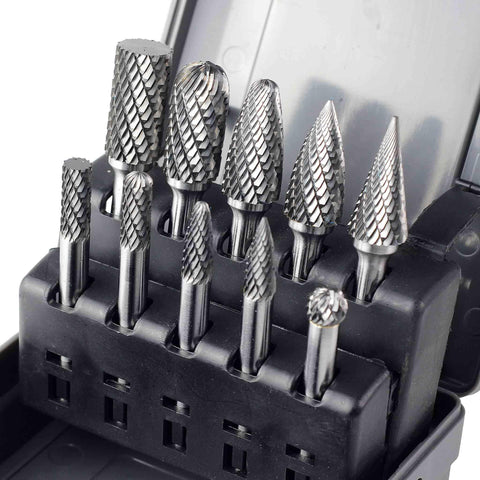
Carbide burrs are incredibly versatile tools known for their strength, precision, and ability to handle tough materials. Typically used in die grinders, these rotary tools have applications in metalworking, woodworking, and even some automotive repairs. However, a common question arises: Can you use a carbide burr in a drill? The answer is yes, but there are important considerations to keep in mind to maximize efficiency, maintain safety, and get the best results. Let's explore how carbide burrs function in a drill, the advantages and challenges of doing so, and the techniques required to optimize their performance.
Carbide burrs are essentially small cutting tools made from tungsten carbide, one of the hardest materials available. This toughness allows them to work on a wide range of materials, including metals, hardwoods, stone, and plastic. They come in various shapes - cylindrical, conical, spherical - each designed for specific tasks like cutting, shaping, or deburring. While carbide burrs are primarily used in high-speed die grinders, they can indeed be used in drills if handled correctly.
One of the key differences between a die grinder and a drill is the speed at which they operate. Die grinders rotate at very high speeds - typically between 10,000 and 30,000 RPM (rotations per minute). In contrast, most standard drills operate at much lower speeds, often between 1,000 and 3,000 RPM. Carbide burrs perform optimally at high speeds, which allows them to make smooth cuts and avoid jamming or skipping. Using a burr in a drill that operates at lower speeds can limit its effectiveness, especially on harder materials like steel or cast iron. However, for softer materials like wood or plastic, a drill's lower speed may be adequate.
When using a carbide burr in a drill, it's crucial to select the right type of drill. Corded drills tend to offer more consistent power and speed compared to cordless models. If you're working with metal, a drill press may be a better choice than a handheld drill, as it provides more stability and precision. The rigidity of a drill press ensures that the burr doesn't wobble or shift during use, which could damage the workpiece or even the tool itself.
Another factor to consider is the type of burr you're using. Because drills operate at lower RPMs, it's important to choose carbide burrs designed for slower speeds. Burrs with coarser flutes or teeth are better suited for use in a drill because they can remove material more efficiently at reduced speeds. Fine-toothed burrs, on the other hand, may struggle to perform well in a drill, especially when working with hard materials, because they require higher speeds to cut smoothly.
While it's entirely possible to use a carbide burr in a drill, it's not always ideal for high-precision work. Drills aren't designed for the fine, detailed control that die grinders offer. If your goal is intricate work - such as detailed carving or finishing - it's generally best to stick with a die grinder. That said, for rougher tasks like removing excess material, deburring metal edges, or enlarging holes, using a carbide burr in a drill can be a quick and effective solution.
It's also important to emphasize safety when using a carbide burr in a drill. These tools can produce sharp metal or wood shavings, which pose a risk of injury if proper precautions aren't taken. Always wear safety goggles, gloves, and long sleeves to protect yourself from flying debris. Additionally, make sure to clamp down your workpiece securely, especially when working with metal, to prevent any unwanted movement that could lead to accidents.
Proper technique is essential when using a carbide burr in a drill. It's recommended to let the tool do the work without applying excessive pressure, as this can cause the burr to bind, overheat, or wear out prematurely. Allow the burr to rotate freely while guiding it steadily across the workpiece. Use smooth, even motions to avoid chipping or gouging the material. If working on a metal surface, using a lubricant can help reduce friction and heat buildup, extending the life of both the burr and the drill.
Finally, consider the wear and tear on both the drill and the carbide burr. Since drills operate at lower RPMs, they can cause the burr to dull more quickly than a die grinder would. Similarly, a drill may experience more strain than it's built to handle when working with hard materials. It's important to check the condition of both the drill and the burr regularly, and to replace them when necessary to ensure continued efficiency and safety.
In conclusion, using a carbide burr in a drill is entirely feasible, provided you're aware of the limitations and make the necessary adjustments. With the right technique, proper equipment, and an understanding of the material you're working with, carbide burrs can become a versatile addition to your drill's toolkit, expanding its functionality beyond basic drilling tasks.